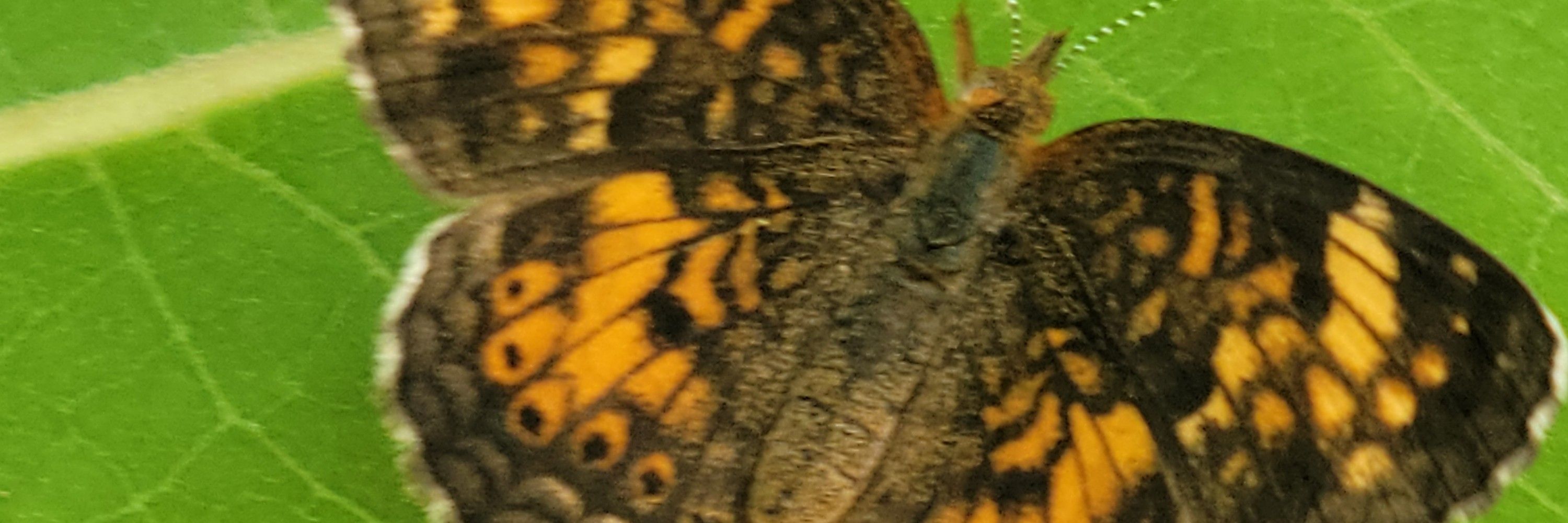
Yan Boulanger
@trailgeek.bsky.social
Research scientist in Forest Ecology🌲| Working on climate change stuff and wildfires🔥| Like trail running and singing in my car
Same here... eh boboy

April 1, 2025 at 1:48 AM
Same here... eh boboy
Don't forget that this is considering a species distribution model (SDM) When using a multimodel approach, which includes both SDM and process-based models, iy appears that aspen might take advantage of increased climate-induced disturbances. Up to a certain point...
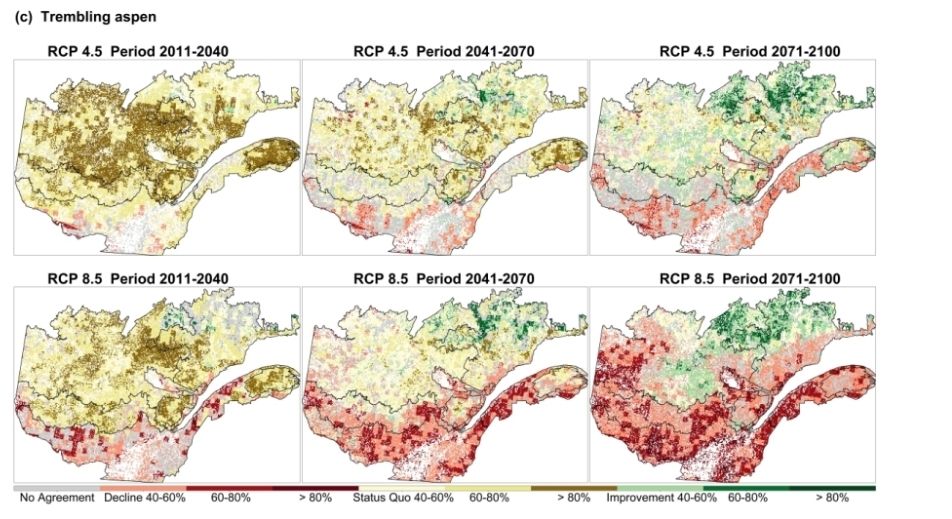
February 25, 2025 at 1:50 AM
Don't forget that this is considering a species distribution model (SDM) When using a multimodel approach, which includes both SDM and process-based models, iy appears that aspen might take advantage of increased climate-induced disturbances. Up to a certain point...
3/ 🌎 Most importantly, climate change is a bigger driver of SBW dynamics than landscape changes!
This means forest ecosystems are being reshaped faster than we expected, requiring adaptive management strategies.
This means forest ecosystems are being reshaped faster than we expected, requiring adaptive management strategies.


February 15, 2025 at 2:36 PM
3/ 🌎 Most importantly, climate change is a bigger driver of SBW dynamics than landscape changes!
This means forest ecosystems are being reshaped faster than we expected, requiring adaptive management strategies.
This means forest ecosystems are being reshaped faster than we expected, requiring adaptive management strategies.
2/ 📈 Key findings (1950–2022):
📍 +68 km northward shift of suitable climate conditions (up to 200 km in some areas!)
⏳ Earlier phenological events & higher reproduction rates in the north
❄️ Increased winter mortality in the south due to warmer temperatures
📍 +68 km northward shift of suitable climate conditions (up to 200 km in some areas!)
⏳ Earlier phenological events & higher reproduction rates in the north
❄️ Increased winter mortality in the south due to warmer temperatures

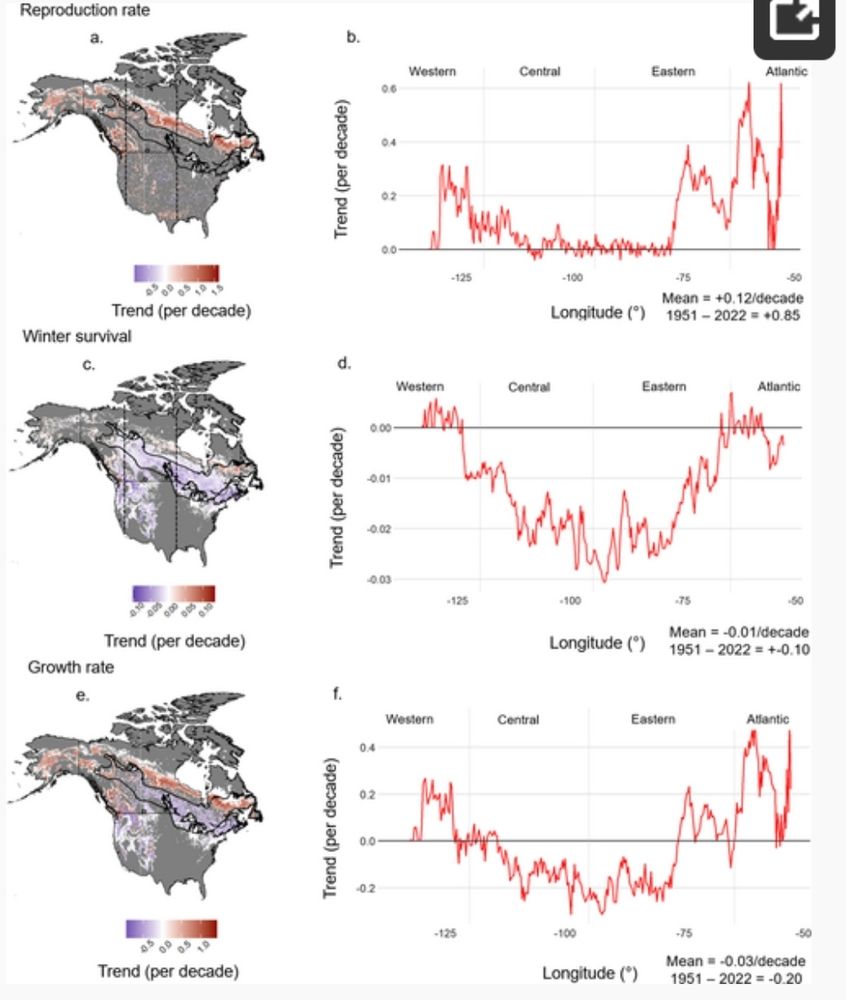
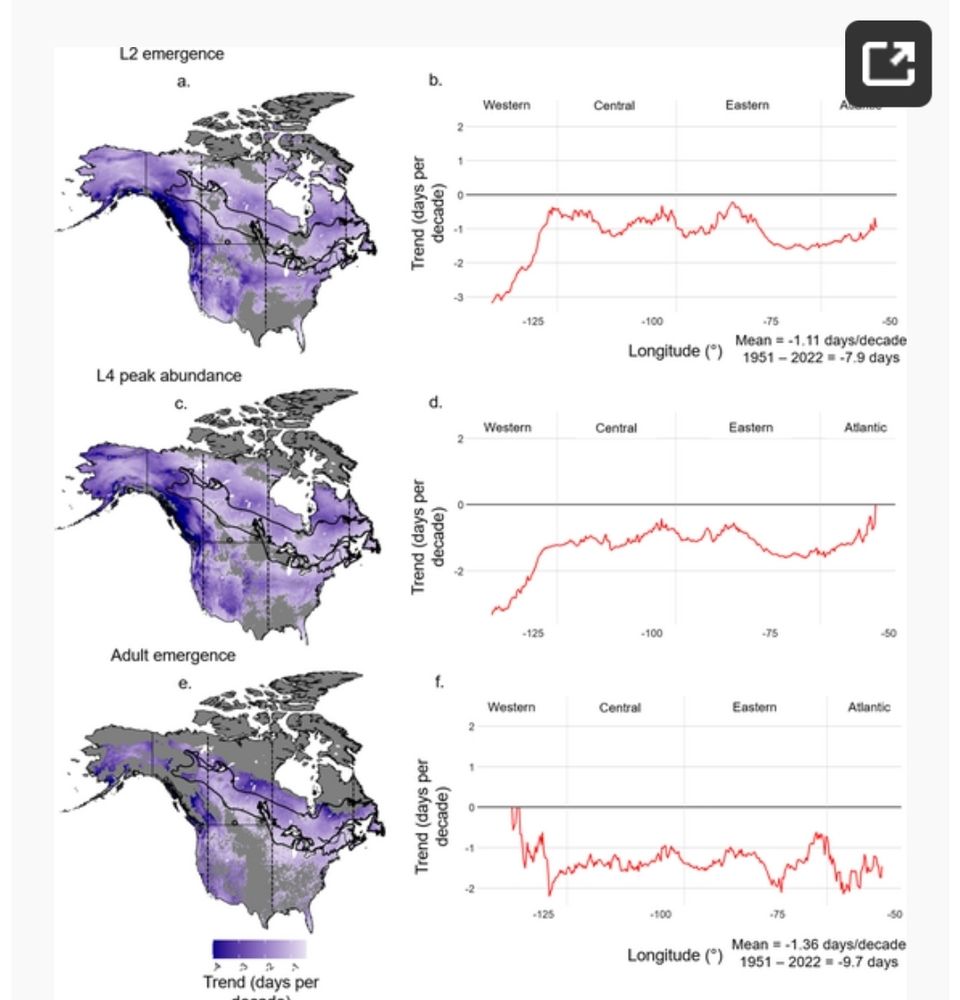
February 15, 2025 at 2:35 PM
2/ 📈 Key findings (1950–2022):
📍 +68 km northward shift of suitable climate conditions (up to 200 km in some areas!)
⏳ Earlier phenological events & higher reproduction rates in the north
❄️ Increased winter mortality in the south due to warmer temperatures
📍 +68 km northward shift of suitable climate conditions (up to 200 km in some areas!)
⏳ Earlier phenological events & higher reproduction rates in the north
❄️ Increased winter mortality in the south due to warmer temperatures
1/ 🌲🔬 New Research Alert! 🌡️🦋
#ClimateChange is reshaping forest ecosystems, and the spruce budworm (Choristoneura fumiferana), a major boreal forest defoliator, is feeling the heat! 🔥
Our latest study in PLOS Climate reveals some striking trends. 🧵👇
#ClimateChange is reshaping forest ecosystems, and the spruce budworm (Choristoneura fumiferana), a major boreal forest defoliator, is feeling the heat! 🔥
Our latest study in PLOS Climate reveals some striking trends. 🧵👇

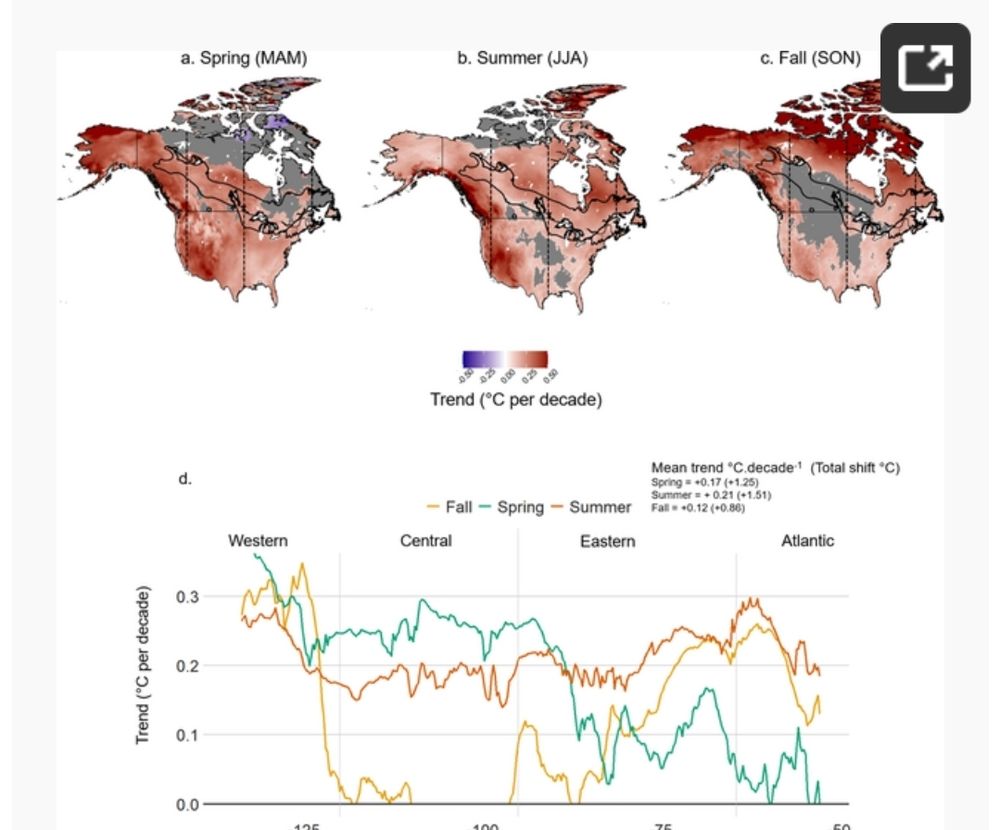
February 15, 2025 at 2:35 PM
1/ 🌲🔬 New Research Alert! 🌡️🦋
#ClimateChange is reshaping forest ecosystems, and the spruce budworm (Choristoneura fumiferana), a major boreal forest defoliator, is feeling the heat! 🔥
Our latest study in PLOS Climate reveals some striking trends. 🧵👇
#ClimateChange is reshaping forest ecosystems, and the spruce budworm (Choristoneura fumiferana), a major boreal forest defoliator, is feeling the heat! 🔥
Our latest study in PLOS Climate reveals some striking trends. 🧵👇
5/ 🚫 What didn’t matter much?
Fire exclusion had minimal influence on vegetation composition, indicating that mesophication unfolds over longer timescales.
Modest climate change impacts (1830–2000) pale in comparison to timber harvesting, but future climate shifts could have stronger effects.
Fire exclusion had minimal influence on vegetation composition, indicating that mesophication unfolds over longer timescales.
Modest climate change impacts (1830–2000) pale in comparison to timber harvesting, but future climate shifts could have stronger effects.

January 20, 2025 at 1:10 PM
5/ 🚫 What didn’t matter much?
Fire exclusion had minimal influence on vegetation composition, indicating that mesophication unfolds over longer timescales.
Modest climate change impacts (1830–2000) pale in comparison to timber harvesting, but future climate shifts could have stronger effects.
Fire exclusion had minimal influence on vegetation composition, indicating that mesophication unfolds over longer timescales.
Modest climate change impacts (1830–2000) pale in comparison to timber harvesting, but future climate shifts could have stronger effects.
4/ 🔍 What did we find?
Timber harvesting had the most significant impact on forest dynamics:
🌳 Without harvesting, pre-settlement species composition & traits were largely maintained.
🔥 Fire shifts increased aspen, but their effects were secondary.
🌡️ Climate change had a minor role
Timber harvesting had the most significant impact on forest dynamics:
🌳 Without harvesting, pre-settlement species composition & traits were largely maintained.
🔥 Fire shifts increased aspen, but their effects were secondary.
🌡️ Climate change had a minor role

January 20, 2025 at 1:09 PM
4/ 🔍 What did we find?
Timber harvesting had the most significant impact on forest dynamics:
🌳 Without harvesting, pre-settlement species composition & traits were largely maintained.
🔥 Fire shifts increased aspen, but their effects were secondary.
🌡️ Climate change had a minor role
Timber harvesting had the most significant impact on forest dynamics:
🌳 Without harvesting, pre-settlement species composition & traits were largely maintained.
🔥 Fire shifts increased aspen, but their effects were secondary.
🌡️ Climate change had a minor role
3/ 🛠️ How did we study this?
We used the #LANDIS-II forest landscape model for retrospective analysis (1830–2000), integrating:
🔥 Historical #fire reconstructions
🌡️ #Climate reanalysis data
🌲 #Timber harvest records
Counterfactual scenarios helped isolate the impact of each factor.
We used the #LANDIS-II forest landscape model for retrospective analysis (1830–2000), integrating:
🔥 Historical #fire reconstructions
🌡️ #Climate reanalysis data
🌲 #Timber harvest records
Counterfactual scenarios helped isolate the impact of each factor.

January 20, 2025 at 1:08 PM
3/ 🛠️ How did we study this?
We used the #LANDIS-II forest landscape model for retrospective analysis (1830–2000), integrating:
🔥 Historical #fire reconstructions
🌡️ #Climate reanalysis data
🌲 #Timber harvest records
Counterfactual scenarios helped isolate the impact of each factor.
We used the #LANDIS-II forest landscape model for retrospective analysis (1830–2000), integrating:
🔥 Historical #fire reconstructions
🌡️ #Climate reanalysis data
🌲 #Timber harvest records
Counterfactual scenarios helped isolate the impact of each factor.
2/ 🌳 What’s the study about?
#Forests in northeastern #NorthAmerica have undergone massive changes since pre-settlement times
🟩 Loss of conifers
🌲 Decline in taxonomic & functional diversity
We aimed to untangle the individual effects of timber harvesting, fire regimes, and climate on these shifts.
#Forests in northeastern #NorthAmerica have undergone massive changes since pre-settlement times
🟩 Loss of conifers
🌲 Decline in taxonomic & functional diversity
We aimed to untangle the individual effects of timber harvesting, fire regimes, and climate on these shifts.

January 20, 2025 at 1:07 PM
2/ 🌳 What’s the study about?
#Forests in northeastern #NorthAmerica have undergone massive changes since pre-settlement times
🟩 Loss of conifers
🌲 Decline in taxonomic & functional diversity
We aimed to untangle the individual effects of timber harvesting, fire regimes, and climate on these shifts.
#Forests in northeastern #NorthAmerica have undergone massive changes since pre-settlement times
🟩 Loss of conifers
🌲 Decline in taxonomic & functional diversity
We aimed to untangle the individual effects of timber harvesting, fire regimes, and climate on these shifts.
Simulated emissions from the 2023 wildfires were 8x their 1985–2022 average. Without action, the likelihood of extreme fire seasons—and their impacts on health, society, and ecosystems—will keep rising. 🌲🚨 (5/)

December 20, 2024 at 3:08 PM
Simulated emissions from the 2023 wildfires were 8x their 1985–2022 average. Without action, the likelihood of extreme fire seasons—and their impacts on health, society, and ecosystems—will keep rising. 🌲🚨 (5/)
Using climate models, we show that human-driven climate change significantly increased the likelihood of such an extreme fire season across most of Canada. 🔥🌡️ In the east and southwest, the likelihood was more than doubled. (3/)

December 20, 2024 at 3:07 PM
Using climate models, we show that human-driven climate change significantly increased the likelihood of such an extreme fire season across most of Canada. 🔥🌡️ In the east and southwest, the likelihood was more than doubled. (3/)
The 2023 fires caused unprecedented evacuations, severe air quality impacts across Canada and the northeastern US, and immense strain on fire management resources. 🚨 How did human-induced climate change play a role? (2/)

December 20, 2024 at 3:06 PM
The 2023 fires caused unprecedented evacuations, severe air quality impacts across Canada and the northeastern US, and immense strain on fire management resources. 🚨 How did human-induced climate change play a role? (2/)
🔥 In 2023, wildfires burned a record-breaking 15 million hectares in Canada—more than twice the previous record. Our new paper in Nature Communications explores the drivers behind this catastrophic season. 🌍 [Link: www.nature.com/articles/s41... 🧵 (1/)

December 20, 2024 at 3:05 PM
🔥 In 2023, wildfires burned a record-breaking 15 million hectares in Canada—more than twice the previous record. Our new paper in Nature Communications explores the drivers behind this catastrophic season. 🌍 [Link: www.nature.com/articles/s41... 🧵 (1/)
As mentioned by @meteomedia.bsky.social, several cities in #Quebec have recorded their warmest meteorological fall (SON) in 2024 since record began. A +3°C anomaly is quite something for a 3-month period.
#wx
#wx

December 1, 2024 at 10:28 PM
As mentioned by @meteomedia.bsky.social, several cities in #Quebec have recorded their warmest meteorological fall (SON) in 2024 since record began. A +3°C anomaly is quite something for a 3-month period.
#wx
#wx
Offre de #stage/#Internship possibily
Impacts of time since last #wildfire on forest composition and structure of the Lac Hebecourt islands
#uqat
Impacts of time since last #wildfire on forest composition and structure of the Lac Hebecourt islands
#uqat

November 27, 2024 at 2:10 PM
Offre de #stage/#Internship possibily
Impacts of time since last #wildfire on forest composition and structure of the Lac Hebecourt islands
#uqat
Impacts of time since last #wildfire on forest composition and structure of the Lac Hebecourt islands
#uqat
Pictures taken by my son, of our beautiful #samoyeds playing in the first #snow of the 2024-25 winter in #Quebec City
Follow him at www.instagram.com/mael_boulang...
Follow him at www.instagram.com/mael_boulang...



November 27, 2024 at 11:20 AM
Pictures taken by my son, of our beautiful #samoyeds playing in the first #snow of the 2024-25 winter in #Quebec City
Follow him at www.instagram.com/mael_boulang...
Follow him at www.instagram.com/mael_boulang...

November 20, 2024 at 5:28 PM
#TrailRunning with #Samoyeds during fall




November 17, 2024 at 8:05 PM
#TrailRunning with #Samoyeds during fall
Le 21 novembre prochain, je présenterai dans le cadre de la conference "Santé et Qualité de l'Air : Enjeu de societe majeur" de l'Association pour la prévention de la contamination de l'air et du sol concernant le futur des #feuxdeforêts au #Canada et son entrée dans le "pyrocene"


November 16, 2024 at 4:20 PM
Le 21 novembre prochain, je présenterai dans le cadre de la conference "Santé et Qualité de l'Air : Enjeu de societe majeur" de l'Association pour la prévention de la contamination de l'air et du sol concernant le futur des #feuxdeforêts au #Canada et son entrée dans le "pyrocene"
🔥🔥Bar des sciences demain à Saguenay afin de répondre à vos questions sur les 🔥feux de🌲 forêt autour d'une bonne broue!🍺


November 5, 2023 at 5:10 PM
🔥🔥Bar des sciences demain à Saguenay afin de répondre à vos questions sur les 🔥feux de🌲 forêt autour d'une bonne broue!🍺
9/ Conclusion: Even when the world is rapidly changing, focusing on #conserving a single species (like the #caribou) can have a ripple effect, benefiting a range of other species. It underscores the value of targeted #conservation efforts.

October 26, 2023 at 2:50 PM
9/ Conclusion: Even when the world is rapidly changing, focusing on #conserving a single species (like the #caribou) can have a ripple effect, benefiting a range of other species. It underscores the value of targeted #conservation efforts.





